Where Do Pigeons Nest? Wild or Domestic
Pigeons stand out as one of the most familiar birds in this world. Researchers have been studying their diet, nesting patterns, breeding habits, and mating behavior for quite some time now.
So, you might wonder, where do pigeons nest? Interestingly, pigeons are among the few birds that can live in densely populated cities. The most preferred nesting spots of pigeons often include the following.
- Old buildings
- Mud pots
- Fuse box
- Ledges
- Railway stations
- Mailbox
- Air conditioner box
In this article, we will discuss the most common places where pigeons prefer to build their nests. Plus, we will talk about the quality and stability of these pigeon nests. So, let’s get started!
Want to know more about pigeon habitats:
Do Pigeons Build Their Nests in Trees?
Unlike other birds, pigeons prefer not to build their nests on trees.
Researchers from Villupuram stated in their journal that pigeons hardly build their nest on trees.
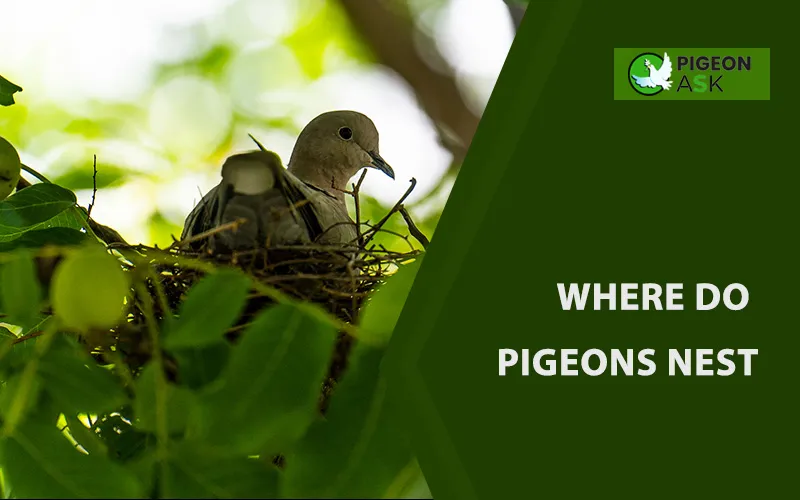
The researchers found that pigeons usually make their nests in various artificial places, such as –
- Mud pots
- Fuse box
- Ledges
- Forts
- In the gaps between rocks
- Old buildings
- Broken statues
- Window shields
- Stone infrastructures
- Air conditioner box
- Metal beams in bridges, etc.
You will most likely see pigeons around warehouses, grain markets, buildings, railway stations and parks where coarse grains are widely available.
Another study revealed that the following factors adversely affect where pigeons choose to build their nests –
- Amount of grass on the ground
- The number of trees in a city block
- The presence of tree canopies
- The distance of the nesting location from potential predators
This suggests that pigeons prefer to build their nests in highly developed areas. Researchers from Swami Ramanand Teerth Marathwada University conducted a study on where pigeons choose to build their nests.
In their study, the researchers found that feral pigeons prefer to build their nests on human-made structures rather than in their natural surroundings.
Check out the table we have added below. Here, we have listed the places pigeons tend to favor for nesting.
| Nesting Location | Percentage of Pigeons Nesting In This Location |
|---|---|
| Under Building’s Roof | 33% |
| Above The Lintel | 13% |
| On Windshield | 33% |
| In Readymade Boxes | 20% |
| Rock Crevices | 1% |
However, over the past ten years, people have occasionally seen pigeons nesting on Platanus trees in Italy. Take a look at the picture we have provided below.
Here, you can clearly see a pigeon resting in its nest on a tree branch.
Researchers believe this could be happening because more old buildings are being torn down. These old buildings had holes and nooks as a part of their design.
However, modern infrastructures do not have large holes where pigeons can build their nests. Plus, people do not dig new wells and build side walls as often as they used to.
You can read our article about “Pigeon Habitat“
Why Do Wild Pigeons Choose Specific Nesting Locations?
It is known that wild pigeons consider an array of variables while choosing where to build their nests.
The idea of the “birthplace,” or the area where they were born and raised, is one of the main elements that affects their decision on where to build their nest.
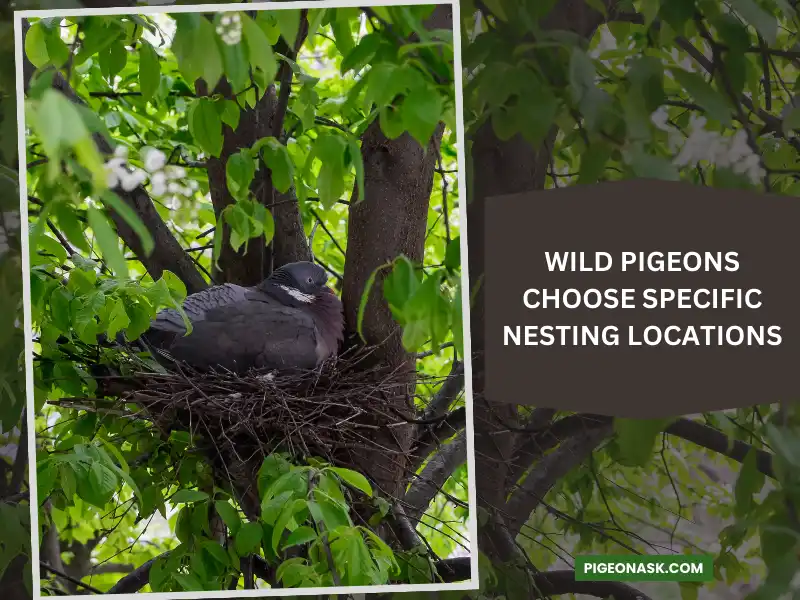
Their nesting behavior is significantly impacted by this birthplace aspect.
01. Imprinting and Familiarity: Soon after hatching, wild pigeons, like many other bird species, go through a process known as imprinting. They develop deep bonds to both their parents and the particular place they were raised during this crucial time.
Here, they pick up essential survival and navigational skills, and this location becomes their “home base.” Because they are most familiar with their birthplace, as adults, they are more likely to return there or build a nest nearby.
02. Site Safety and Familiarity: A sense of security is provided by the birthplace’s familiarity. Since this is a known and somewhat safe area for them to raise their young, pigeons are more inclined to select nesting locations near this familiar terrain.
They choose their nesting place based on their awareness of the available food sources, water supplies, and potential predators in the area.
03. Competitive Advantage: Having a competitive edge might also result from returning to one’s birthplace to nest. Pigeons who are used to their surroundings are better able to compete for ideal nest locations and secure resources. Their ability to successfully reproduce may depend on their understanding of the area.
Switching Places
Not every pigeon nests in the area where it was born. Depending on the situation, they may relocate. Depending on whether the pigeons are in an urban or rural environment, these conditions may change.
In Urban Environments: Changes in food supply, disruptions from humans, or competition for nest sites can cause pigeons to move their nests.
They are renowned for being adaptive and can fit in with urban environments where they may find shelter and food.
If their original position proves unsuitable or if there is excessive competition from other pigeons, pigeons may relocate to a new nesting site.
In Rural Areas: Since the natural environment is usually more stable in rural regions, pigeons are more likely to show site fidelity to their birthplace.
Still, they might relocate in reaction to shifts in the available resources in the area, including variations in the availability of food or water.
Why Do They Choose Urban Areas?
Pigeons originated from rocky cliffs and still prefer tall buildings and concrete structures that mimic their ancestral cliff homes.
The abundant ledges, holes, and crevices in cities provide ideal nesting spots, allowing pigeons to easily establish nests.
In building their nests, pigeons favor quick, simple construction using whatever materials are readily available rather than sturdy, intricate nests.
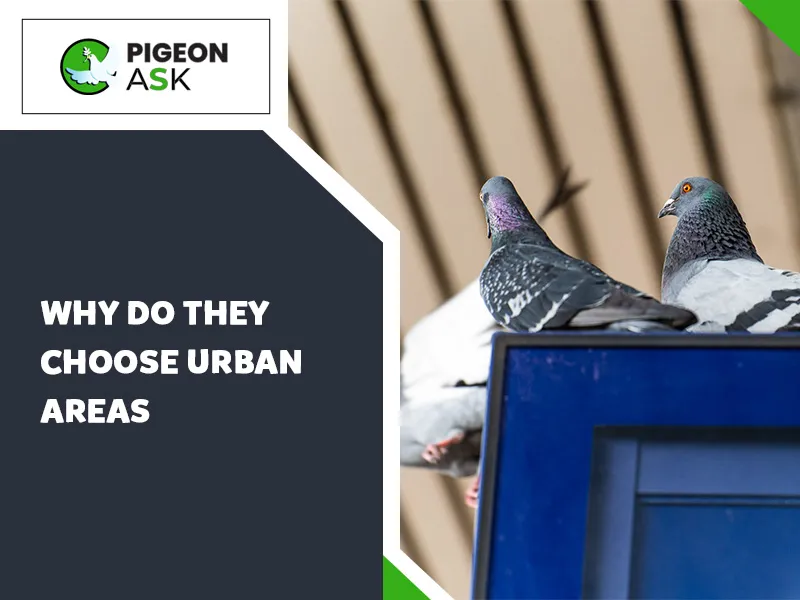
They will take the chance to nest anywhere convenient in cities, rather than invest time and energy finding quality materials or locations. This rapid, opportunistic approach to nest building allows them to thrive.
Additionally, because pigeons reuse old nests rather than building new ones each time, their nests accumulate materials and grow stronger over successive generations. The increasingly large and durable nests further enable their success.
By opportunistically constructing nests out of urban materials on mimics of their ancestral rocky homes, pigeons are able to rapidly reproduce and flourish.
Their flexible, low-investment nesting strategy perfectly suits the urban landscape. This nesting behavior, combined with ample food and safety, facilitates pigeons’ dominance across cities globally.
Urban And Rural Location-Determining Factors
Urban Regions
Food Availability: One important consideration when choosing a nesting place for urban pigeons is the availability of food supplies, such as leftover human food.
Shelter and Roosting Sites: Pigeons have a preference for nesting places that offer protection from the weather and possible predators. Buildings, ledges, and eaves mostly caters to this purpose in urban areas.
Human Disturbance: Pigeons may stay away from places where there is a lot of noise and human disturbance.
Rural Regions
Natural Environment: In rural settings, the accessibility of freshwater sources, grains, and seeds influences pigeon’s nesting.
Nesting Sites: They pick areas with ledges, cliffs, or alcoves that are ideal for nesting.
Presence of Predators: It’s crucial for the protection of their offspring to stay away from regions with large concentrations of predators.
What Are the Characteristics of a Pigeon Nest? – A Detailed Overview
Below, we have listed the common features of the nests constructed by feral and domestic pigeons.
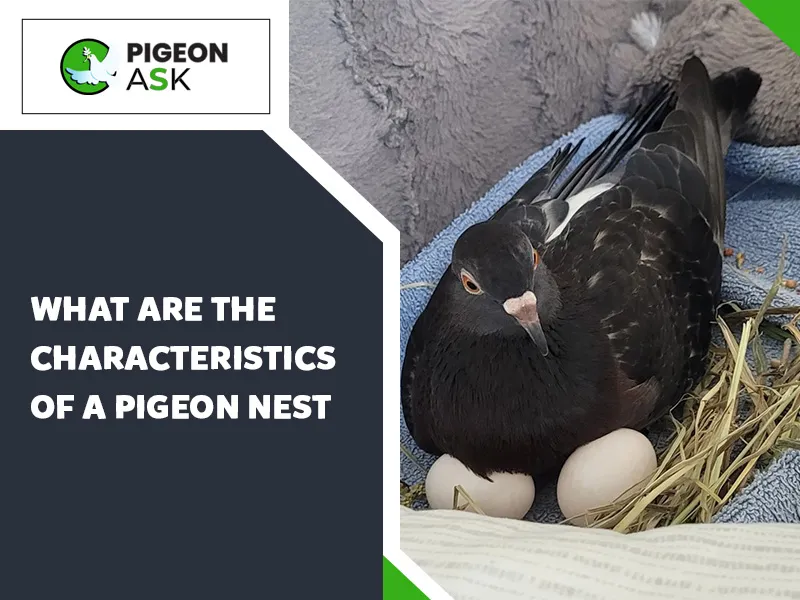
The Shape, Size and Stability of the Nest
Pigeons build their nests gradually and the nests are never uniform in structure. According to researchers, the shape, size and stability of a pigeon’s nest depend on the following factors –
- The spot where the pigeon builds its nest
- The amount of space available
- The materials used to build the nest.
Take a look at the picture we have attached below. In it, you will notice that the shape of the pigeon’s nest is almost perfectly oval and has a dent in the middle.
According to a journal, feral pigeons tend to use leaves and sticks of similar size and length while making their nests. Thus, most of the time, their nest is almost oval in shape.
The typical size of this kind of nest is around 22-25 centimeters.
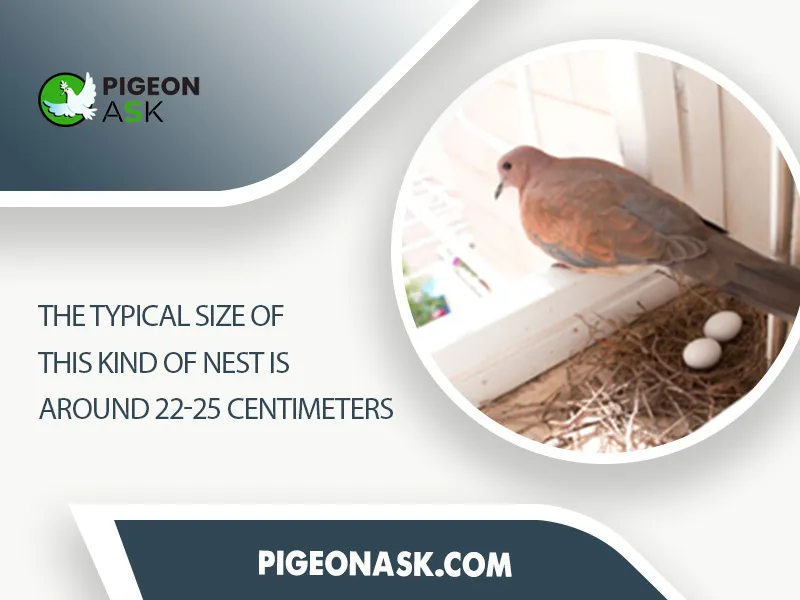
Now, take a look at the following picture. Here, you will notice the pigeon has built its nest a bit haphazardly on a mud pot. Pigeons frequently create their semi-circular nests in pots, boxes, or other available spaces.
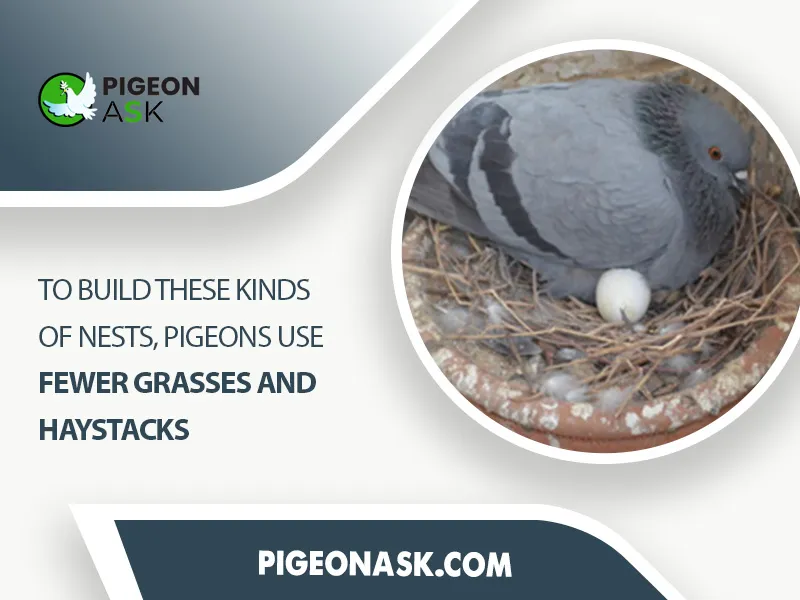
Materials Utilized as the Nest’s Foundation
As per researchers, pigeons use a variety of stray materials that they can find to build their nests. Below, we have listed some common materials used by feral pigeons to construct their nest:
- Twigs
- Small sticks
- Haystacks
- Grasses
- Hair
- Leaves
- Fern
- Moss
- Feathers
Take a look at the graph we have added here. It shows the most common natural materials that pigeons use to build their nests.
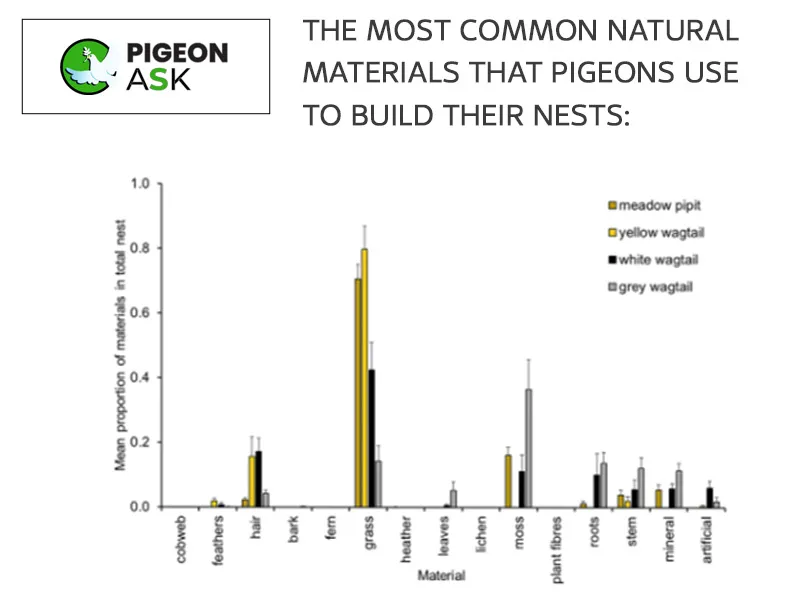
Construction workers in Accrington discovered a pigeon nest made from rusted nails, screws and scraps of metal.
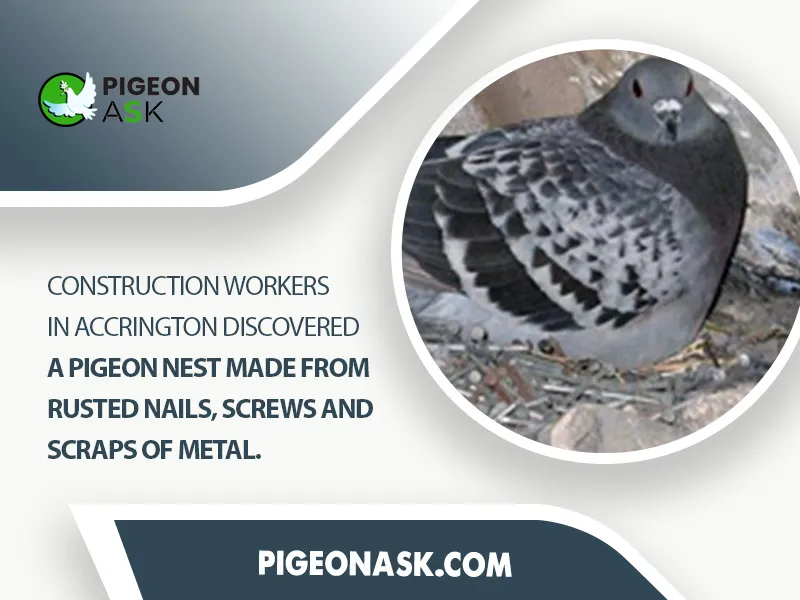
According to a study, the materials pigeons choose for their nests depend on a few key factors:
1) The material should provide strong structural support for the eggs.
2) The material should prevent the buildup of pathogens.
3) It should properly hide the eggs.
4) The nesting material should help keep the pigeon’s eggs from cooling too quickly.
5) The material should help camouflage the pigeon’s nest.
Nests Are Built 15 Meters Above the Ground
Researchers found that the majority of pigeons prefer building their nests at heights of 15 meters and 20 meters. A smaller number of pigeons choose to nest at 18 meters and 17 meters.
You can see this data visually represented in the graph we have provided below.
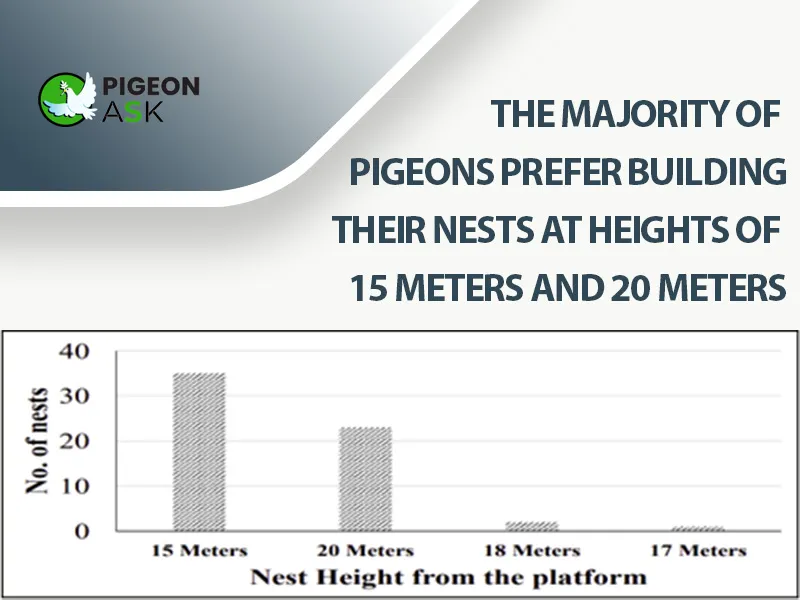
How Long Do Pigeons Nest For?
Pigeon eggs typically take around 432 hours (18 days) to hatch. Once the eggs hatch, the parent pigeons care for and protect the baby pigeons for approximately 696-720 hours (29-30 days).
After this period, the young pigeons will leave the nest. Then, the parent pigeons may use the existing nest for the next breeding cycle.
According to bird experts, the duration a pigeon stays in a specific nesting spot depends on the following things –
- The availability of food in that area
- The presence of predators around the nesting area
- How well the pigeon pair can successfully breed and care for their squabs
- The level of noise and light pollution in the nesting location.
Why Do Pigeon Nests Look So Bad?
Male birds with more experience tend to gather and add more materials to the nest compared to less experienced birds.
Additionally, pigeon nests tend to get dirty more quickly compared to nests of larger birds. This is because a large bird in a small nest will defecate outside the nest.
But pigeons tend to be small in size and often defecate inside their nests.
Researchers also noticed that pigeons sometimes may use the same nest two or three times after the young pigeons have left the nest. Thus, the nest loses its structure and becomes dirtier over time.
Do Pigeons Need Nesting Boxes?
In recent years, the growth of modern infrastructures in urban areas has decreased the available nesting spots for pigeons. Thus, the nest boxes were created to provide pigeons and other birds with a stable nesting spot.
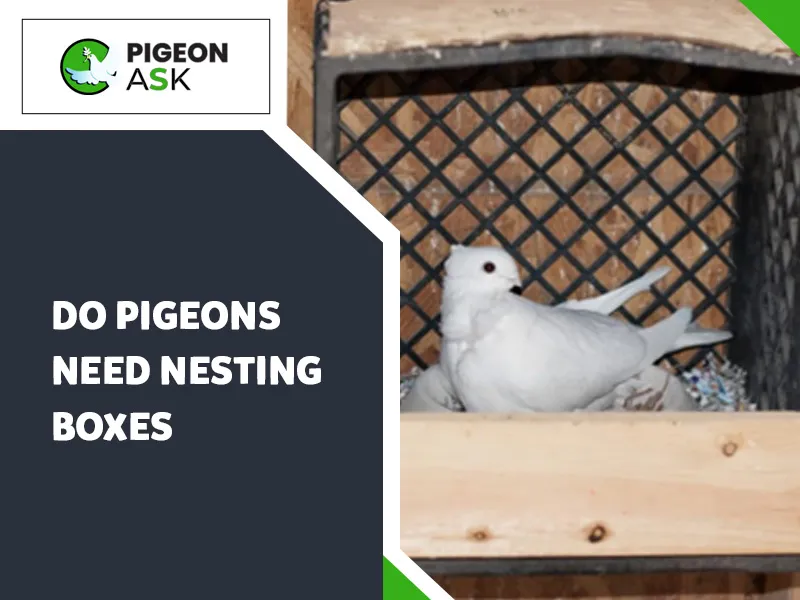
According to experts, over the past 5 years, nest boxes have mitigated the following issues –
- The shortage of holes is caused by a lack of trees with large diameters
- Damage to existing tree holes due to storms, typhoons and other natural disasters
- Dead and decayed trees were removed from forests
- Fewer nesting locations are available for birds
What Size Nest Box Should Be Used to House Pigeons?
Check out the table below to determine the proper of the nest box to keep a pigeon.
| Factors | Measurements |
|---|---|
| Box Size | Length should be 24 inches The width should be 30 inches The depth should be 24 inches Height should be 16-18 inches |
| Size of Entrance Hole | 3-3.5 inches |
| Height Above the Ground | 2-3 meters |
| Distance Between Each Box | 20-30 meters |
For more information on pigeon nest boxes, you can watch this YouTube video.
What Is the Perfect Nest for Pigeons?
Therefore, you can house them in a wooden box or mud pot filled with sand and dry grass as a substrate. They will make it their home in these.
When it comes to setting up a pigeon’s nest and selecting the location of the nest, there is no fixed rule that you can follow. You should observe how your pet pigeon reacts after being exposed to its man-made nesting spot.
If you notice aggressive behavior towards the nest, you should change the location, substrate, or dimensions of the nest.
Just make sure that you choose a nesting spot that matches the natural nesting location of the pigeon. Plus, ensure it has food and water available around its nesting spot.
Nesting Pigeons Kept as Pets
Different nesting behaviors are displayed by fancy breeds and homing pigeons that are kept as pets. Unlike wild pigeons, they do not have the same innate bonds to their birthplace.
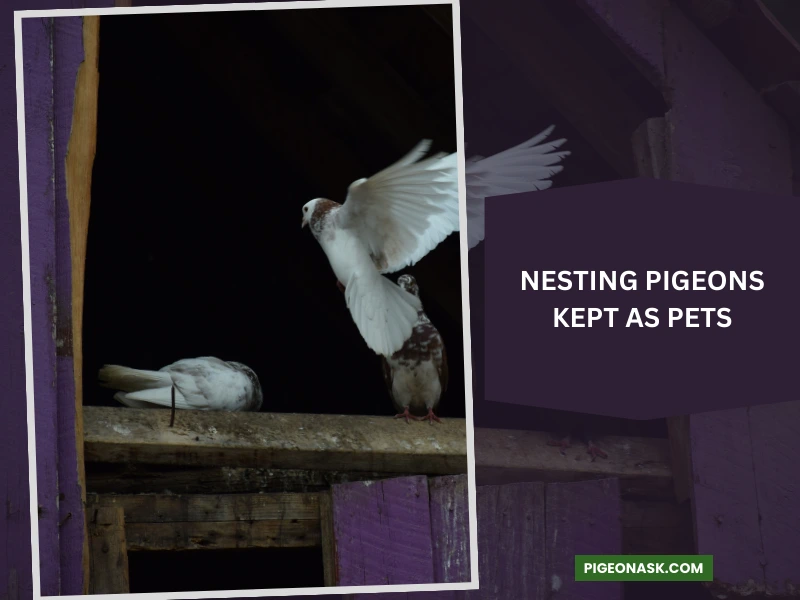
They still require a secure and cozy space to nest, though. Usually, pet pigeons are dependent on their owners for nest boxes and other care.
The presence of other pets, the degree of human interaction in their living area, and the availability of a suitable nest box are some of the variables that may influence where they choose to nest.
Compared to wild pigeons, pet pigeons have a more regulated nesting environment.
Do Wild Pigeons Nest in Urban Areas?
The ability of wild pigeons to adapt to urban settings is impressive. In cities, they frequently decide to build their nests on ledges, rooftops, window sills, balconies, eaves and overhangs, chimneys, abandoned places and other structures.
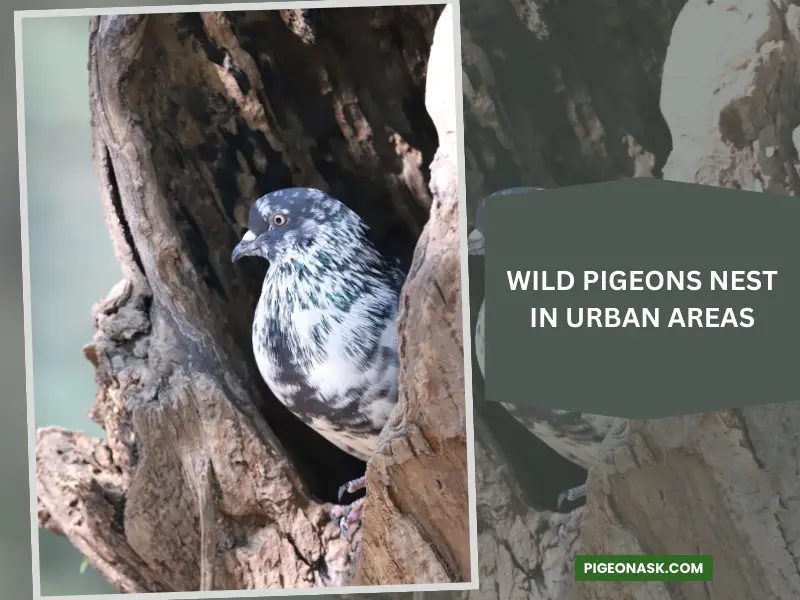
They are drawn to the amount of food scrap found in urban areas. Gladly, the urban landscape offers plenty of places to roost.
As a result, you will often encounter wild pigeons making their nests in and around city structures and public areas.
Uncommon Urban Nesting Sites
The fact that pigeons may make their nests in a variety of urban settings is evidence of their adaptability and inventiveness.
Pigeons frequently choose their nesting sites in urban contexts based on things like safety, shelter, and food availability, even though some of these spots may be less popular.
Hanging Baskets: Although it is less frequent, pigeons occasionally decide to build their nests in hanging planters or flower baskets.
Air Conditioner Units: Drawn by the warmth produced by the machinery, pigeons have been known to build their nests behind or atop air conditioner units.
Public Transportation Structures: Pigeons may build their nests close to train stations, bus stops, or subway platforms, where they will look for local food and shelter supplies.
Park Structures: Pigeons can build their nests in park structures, gazebo roofs, and any other accessible raised platform in urban parks.
Signs and Billboards: Taking advantage of flat surfaces, pigeons have been seen building their nests atop enormous signs and billboards.
Bridge Supports: Pigeons may build their nests on the supports under bridges in regions where there are both water bodies and bridges.
High-Rise Building Features: Pigeons have been known to build their nests on architectural elements like statues and ornamental ledges found on tall skyscrapers.
Do Wild Pigeons Nest in Rural Areas?
Although wild pigeons frequently nest in urban areas, their range extends beyond cityscapes. Rural areas are also home to wild pigeon nests, especially when there are enough nesting grounds and food sources.
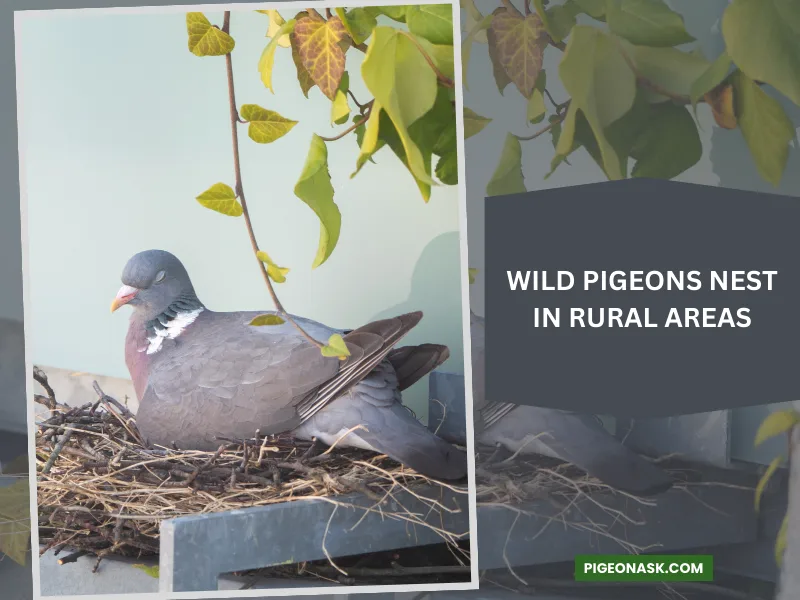
Depending on the local environment, they may build their nests in barns, cliffs, and other man-made or natural structures in rural areas.
Do Wild Pigeons Build Nests or Use Existing Structures?
Wild pigeons are adaptable builder birds. They have the ability to construct nests as well as use pre-existing buildings.
But they are also as happy to live in protected spots such as ledges, nooks, or corners of structures where they don’t have to construct complicated nests from the ground up.
These wild birds usually gather twigs, leaves, and other items to build a nest. Plus, their ability to adapt enables them to flourish in a variety of settings.
What Are the Key Characteristics of a Wild Pigeon Nest?
When deciding where to construct their nests, pigeons take into account a number of variables. These elements play a part in the site’s overall compatibility for successful reproduction and the health of the offspring.
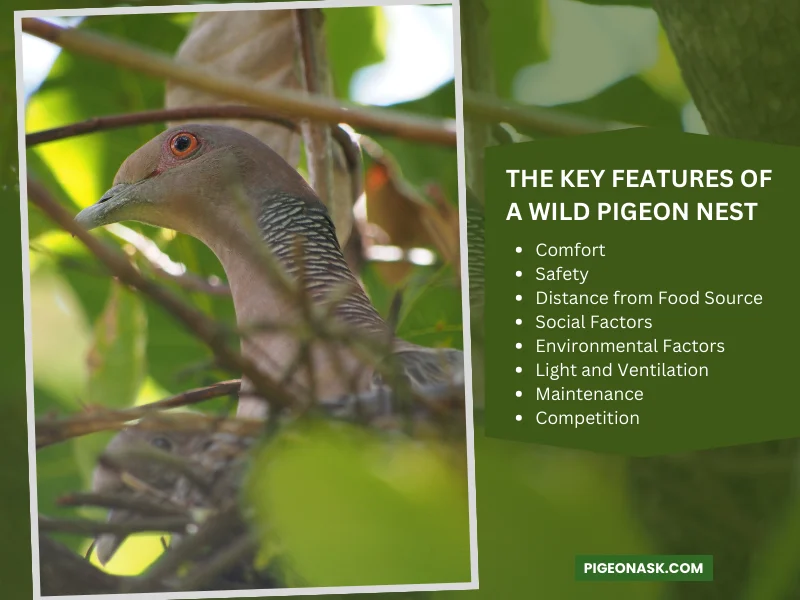
The following are the main variables that affect a pigeon’s choice of nest site:
01. Comfort: Pigeons look for cozy places to build their nests. This involves having a surface that is good for building nests, or at least generally flat. They frequently select window sills, ledges, or other level surfaces that enable them to construct nests and comfortably raise their eggs.
02. Safety: Pigeons prioritize safety above all else when choosing a nesting location. They search for areas that are safe from possible human and natural predators, such hawks and cats. Their nests and young are better protected by elevated locations and shaded areas.
03. Distance from Food Source: Pigeons take into account how close a dependable food source is to their nesting location. Being near a food supply, such in cities where they can find leftover human food, saves them time and energy when they’re out foraging and enables them to feed their young effectively.
04. Social Factors: Because pigeons are gregarious birds, their choices on where to build their nests might be influenced by other pigeons in the area. Pigeons may select locations where they can be near other pigeons for a variety of reasons, such as exchanging food sources or providing group security.
05. Environmental Factors: Pigeons are susceptible to changes in their surroundings. They choose nesting locations that offer some shelter from inclement weather, including rain and intense sunlight. Locations with built-in or natural shelter are preferred.
06. Light and Ventilation: Pigeons like nesting locations with sufficient light and airflow. Temperature can be better controlled in well-ventilated areas, and light can be helpful in finding food and keeping an eye out for danger.
07. Maintenance: Pigeons may pick locations that are generally clear of trash and impediments. Sites that are clean are better sanitary for raising their young.
08. Competition: The existence of other pigeons and their rivalry for nesting locations may also be important considerations. When there is little to no competition for nest sites, pigeons will frequently go for areas with plenty of supplies.
| Nesting Facts | Wild Pigeons |
|---|---|
| Clutch Size | 1-3 eggs |
| Number of Broods | 1-6 broods |
| Incubation Period | 18 days |
| Nestling Period | 25-32 days |
| Egg Description | White |
| Condition at Hatching | Helpless, with sparse yellow or white down |
The Art of Nest Construction
There’s something distinctive about the way wild pigeons build their nests. The male pigeon takes the lead in a mesmerizing courtship show by choosing a nest site that is in close proximity to the female. Here’s more emphasis on it –
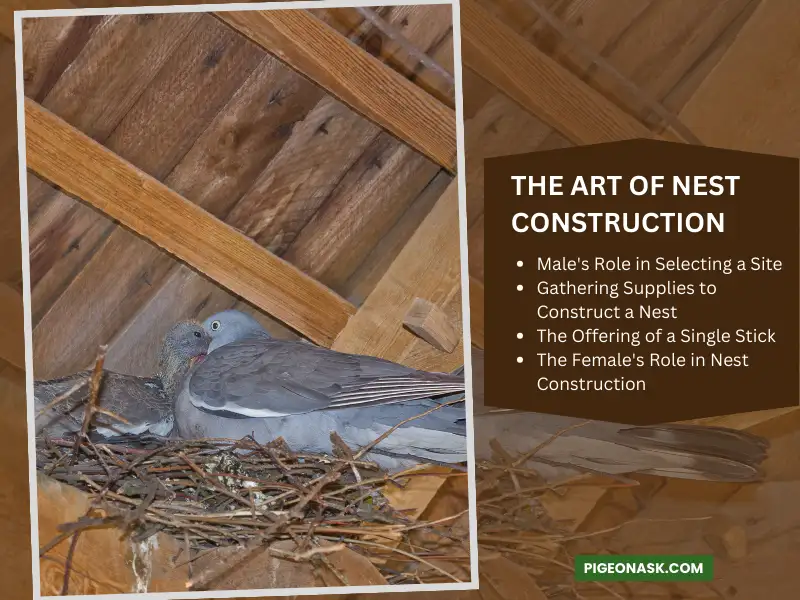
The Male’s Role in Selecting a Site
The crucial task of selecting the nesting location falls to the male pigeon. He looks for a spot that is visible to the female during a courtship display, considering things like safety, shelter, and accessibility to food sources.
Making this decision is crucial to the nest-building process since it determines the layout of their future house as a family.
Gathering Supplies to Construct a Nest
The male pigeon sets out on a resource-gathering journey after selecting the nest site. He gathers materials, mostly twigs and small branches to create nests.
In addition to being useful, gathering these resources shows his dedication to building a suitable nest for his partner and potential offspring.
The Offering of a Single Stick
The male pigeon returns to the selected nest site after gathering a suitable stick or twig to give to the female who is waiting. This gesture indicates his commitment to the nest-building process and is a symbolic offering.
It’s a kind gesture that affirms the male’s responsibility for starting the nest-building process.
The Female’s Role in Nest Construction
The female assumes leadership of the nest’s construction once the male offers her a solitary stick. She takes the stick carefully and lays it under her, positioning it so that it will serve as the nest’s base.
When building a nest, the female plays a crucial role because she carefully organizes the materials, she has gathered to make a safe and cozy area for the incubation of eggs and the upbringing of young.
The male and female’s cooperative work demonstrates how they work together to create a caring environment for their future progeny.
The Practicality of Nest Laid Directly on the Ground
One of the distinguishing features of wild pigeon nesting is the practicality of nests that are placed directly on the ground.
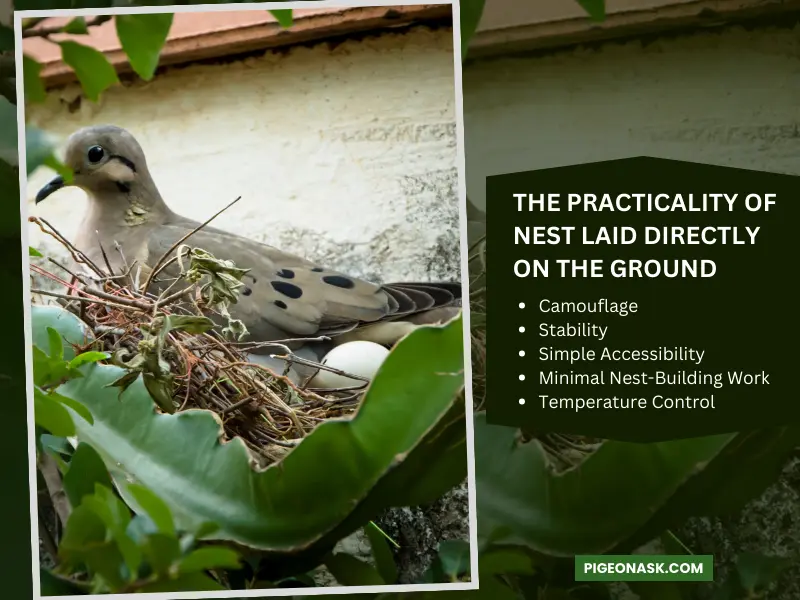
In contrast to numerous other avian species, wild pigeons typically opt to construct their nests directly on the ground, as opposed to elevated nests found in trees or shrubs. This strategy offers a unique combination of useful benefits:
Camouflage
Ground-level nests provide a certain amount of natural concealment. Because pigeon nests are usually made of branches, twigs, and leaves, their ground-level location can aid in their camouflage.
This offers some defense against intruders and predators.
Stability
By nature, ground nests are stable. Compared to nests constructed on ledges or tree branches, they are less vulnerable to strong winds or structural instability.
In order to guarantee the security of the eggs and nestlings, this stability is extremely crucial.
Simple Accessibility
Pigeon parents find it simpler to reach their nests for feeding and incubation when they are positioned on the ground. It does away with the necessity of flying up to a ledge or tree, which can use more energy.
Minimal Nest-Building Work
Compared to creating intricate nests far above the ground, building a nest directly on the ground frequently takes less time and work and uses less materials.
To make building a nest easier, pigeons might arrange leaves and twigs in a shallow hole in the ground.
Temperature Control
Ground-level nests may provide some natural temperature regulation, benefiting the eggs and nestlings. Because of their increased surface contact with the Earth, temperature variations may be lessened.
Conclusion
Overall, pigeons prefer living around developed cities rather than on tree tops like most birds. Pigeons can quickly adapt to urban environments.
Thus, they often choose to build their nests in balconies, gaps in old buildings, stadiums, railway stations, abandoned mailboxes and on top of air conditioners.
Stay connected with our Facebook, Twitter, and Google News handles for more pigeon-related information.
